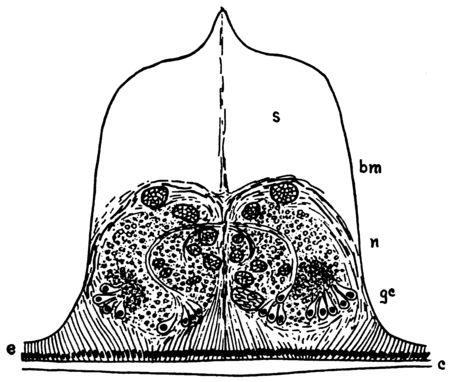organs. The middle and largest of these fibers extends almost the whole length of the ventral cord and, according to Friedländer (1894), has unquestionable connections with ganglion-cells. The two lateral fibers, though smaller, have much the same extent as the median one and are also directly connected with cells. Both sets of fibers connect by branches with the neuropile of the successive segments. Thus the ventral cord of the earthworm may be described as composed of three long neurones and an immense number of overlapping short neurones.
This peculiarity in the structure of the cord makes itself manifest in the movements of the worm. Undoubtedly the slow waves of muscular activity that move over the worm from head to tail as it creeps along are dependent upon the interlocked short neurones, whereas the
Fig. 8. Transverse Section of the Ventral Nervous Cord of Segalion (modified from Hatschek). bm, basement membrane; c, cuticula; e, epidermis; gc, ganglion-cells; n, nerve-fibers and neuropile; s, space occupied by vacuolated supporting tissue.
sudden drawing together of the worm as a whole, when it is vigorously stimulated, is very probably the result of impulses spread through the long neurones.
The absence of degenerated fiber-tracts in the ventral cords of earthworms that have been cut in two and the rapidity with which nervous regeneration takes place in these worms are conditions that very likely depend upon the almost entire formation of the cord from systems of short neurones.
At first sight the central nervous apparatus of the earthworm seems to be widely different from the neuromuscular mechanism of the cœlenterates, but the difference in reality is not so pronounced. To begin with, the whole nervous mechanism of the cœlenterate is within an

